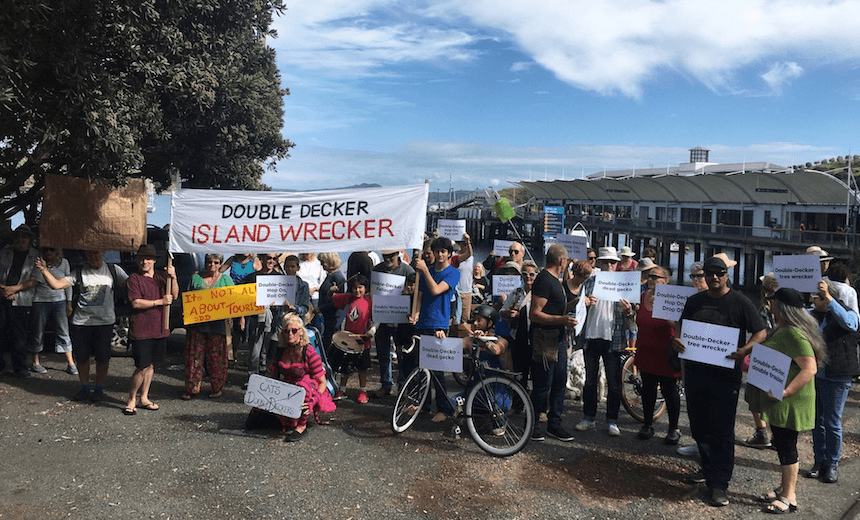The latest skirmish in an epic battle between two Waihekes took place at Matiatia ferry terminal this morning, writes Duncan Greive.
“If they try and do a swifty we’re waiting,” says Susi Newborn, the leader of a protest on a cool, bright morning at the Matiatia ferry terminal on Waiheke. ‘They’ are Fullers, operators of both the ferries which bring people to the island and the new double-decker buses which move them about when they get here. The rumoured swifty is to replace the usual double deckers with a single-storey version to depower their protest. Newborn is determined that they’ll stick it out, come shine or come shine on this very lovely day, until a big bus comes in.
Newborn is wearing a giant flower crown and speaking to a crowd of 60 or so gathered to try and get the buses sent back to the mainland. The double deckers arrived in early December and have become a familiar if incongruous sight on the increasingly populous island. Newborn and her crew have a long list of objections to their existence, including the wear and tear on local roads, their impact on other road users’ safety and the fact road-side native trees have had to be pruned to allow them to operate safely.
Fullers have said that despite being “no longer, heavier or wider” than the single-decker buses they replaced, they can transport far more people. They seem committed to their operation.
Today the protesters will make speeches, march around the roundabout, recreate the Abbey Rd album cover on the ferry zebra crossing and sing a version of “The wheels on the bus” with modified lyrics (“It squeezes down the narrow roads, narrow roads, narrow roads”, etc). The crowd seems legitimately angry about the buses but is also enjoying the opportunity to rail against the things old Waiheke has traditionally railed against: big business, the big nearby city, lack of respect for the natural environment.
“This is a fun protest, Waiheke-style,” says Newborn. She’s one of the founders of Greenpeace, so this is very much not her first protest, nor the most important – the flyer talks about “an opportunity to express your opinion humorously and creatively”. Other creative expressions include a man in a white boiler suit with a tyre mark painted across it, and a lot of banners and slogans:
- “Waiheke needs the double deckers like the dolphins need jet skis”
- “Double decker island wrecker”
- “Double wreckers destroy Waiheke” (a theme developing)
- “2000 trees ordered to be hacked so that double decker buses can “exercise their legal right” to operate on our roads. What about OUR RIGHT…” (some are more succinct than others)
Despite it being easy and very tempting to make fun of what looks like the bougiest protest in human history, the participants are more sympathetic up close than from a distance. Maurice Heta wears a faded Papanui Tigers league t-shirt, and talks about the difficulty he and others have getting around the island now. “They should just go back to the other side and leave these buses,” says Heta, gesticulating at an 80s-era diesel idling at the stop.
For the most part, this is the 80s Waiheke rising up at yet another encroachment onto its way of life. The sleepy, hippy, slightly stoned island is disappearing, overtaken by rich semi-retirees, flash supermarkets and waves of local and international tourists hitting the vineyards. The wineries are separated into demographics which seem to mirror commercial radio – the George FM set at one, the Coast set at the next. Call it obnoxious if you like, but Auckland is getting hectic and weird and gentrified in lots of places right now, and it’s hard to be as sympathetic for Waihekeans as the squeezed residents of Mangere Bridge.
The protest is hearty, but the overall mission seems relatively unlikely to succeed. The vehicles are legal and despite being breathtakingly ugly are also modern and reliable and more environmentally friendly than the old buses they replace, thanks to their more sophisticated engines and their ability to move people around the island with greater per-head fuel efficiency. The reality is that without them, Waiheke would have a lot more single-decker buses, creating bigger snarl-ups at the ferry terminal and more traffic on the roads.
If this is a greenie protest, then, it’s not motivated by concerns about climate change or pollution or traffic congestion. Hence the narrowing of the environmental argument to its impact on native flora.
It’s two Waihekes having another skirmish in the long and relatively affable battle between the way things were and the way they’re going to be. The smiles and good cheer point to the way the protest almost admits to being as much a fun civic-minded family activity as a serious attempt to remove the buses.
This group knows the old island isn’t coming back. But it’s determined not to let its memory die.
The Auckland section is sponsored by Heart of the City, the business association dedicated to the growth of downtown Auckland as a vibrant centre for entertainment, retail, hospitality and business.
